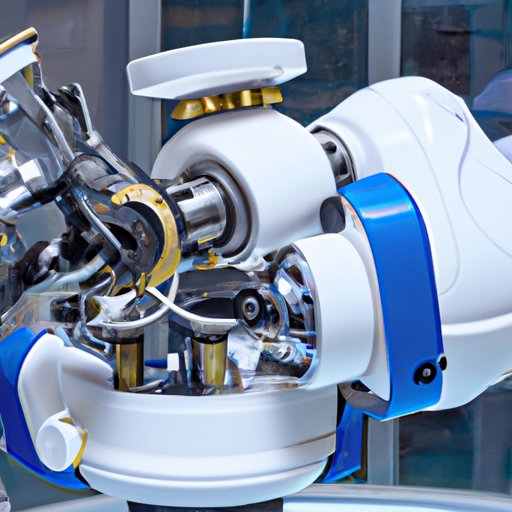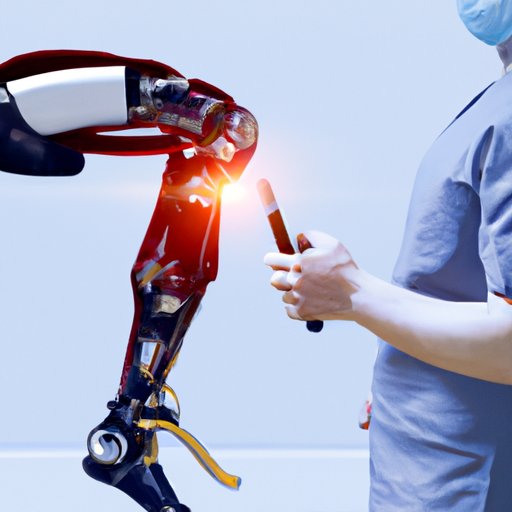Introduction
With advances in medical technology, the field of orthopedic surgery has seen major breakthroughs in recent years. One such advancement is the introduction of robotic knee replacement surgery. This minimally invasive procedure is designed to reduce pain and speed up recovery times for patients who are suffering from severe knee pain or arthritis.
Robotic knee replacement surgery is a type of joint replacement procedure that uses robotic technology to assist surgeons in performing the operation. The goal of this surgery is to provide a more accurate, precise, and successful outcome for the patient. In addition, it can also improve range of motion, reduce postoperative pain, and reduce the risk of complications associated with traditional knee replacement surgery.
Robotic knee replacement surgery is a relatively new technology, so it’s important to understand what it is, the benefits it provides, and the latest technology available. Read on to learn all about robotic knee replacement surgery, including the pros and cons, and how it can improve your quality of life.
Exploring the Benefits of Robotic Knee Replacement Surgery
Robotic knee replacement surgery is a minimally invasive procedure that offers several advantages over traditional open knee replacement surgery. This includes improved accuracy, reduced pain and recovery time, enhanced range of motion, and lower risk of complications. Let’s take a closer look at these benefits.
Improved Accuracy
The most significant benefit of robotic knee replacement surgery is its improved accuracy. According to a study conducted by the Journal of Knee Surgery, robotic knee replacement surgery was found to be more accurate than traditional open knee replacement surgery in terms of implant placement and alignment. This improved accuracy can result in better outcomes for the patient and reduced risk of complications.
Reduced Pain and Recovery Time
Robotic knee replacement surgery is also known for reducing postoperative pain and speeding up recovery times. This is due to the fact that it is a minimally invasive procedure, which means it requires smaller incisions and less tissue disruption than traditional open knee replacement surgery. This can result in less postoperative pain and swelling, as well as a quicker recovery period.
Enhanced Range of Motion
Robotic knee replacement surgery can also help to improve range of motion. This is due to the fact that it allows for more precise placement of the implants, which can result in better alignment and less wear and tear on the joints. This can lead to an improved range of motion and less pain for the patient.
Lower Risk of Complications
Finally, robotic knee replacement surgery is associated with a lower risk of complications. According to a study published in the journal Clinical Orthopaedics and Related Research, robotic knee replacement surgery was found to have a lower rate of complications than traditional open knee replacement surgery. This is due to the improved accuracy and precision of the procedure, which can reduce the risk of infection and other complications.

The Latest Technology in Robotic Knee Replacement Surgery
Robotic knee replacement surgery is constantly evolving, and there are now several different types of technology available. Here are some of the latest technologies being used in robotic knee replacement surgery.
Computer-Assisted Navigation
Computer-assisted navigation is one of the most advanced technologies being used in robotic knee replacement surgery. This technology uses 3D imaging and real-time data to guide the surgeon during the operation. This can help to ensure that the implants are placed accurately and with minimal tissue disruption.
Robotic Arm Assisted Surgery
Robotic arm assisted surgery is another type of technology being used in robotic knee replacement surgery. This technology uses a robotic arm to assist the surgeon in performing the operation. The robotic arm can be programmed to make precise movements, allowing the surgeon to perform the operation with greater accuracy and precision.
Virtual Reality Simulation
Virtual reality simulation is another type of technology being used in robotic knee replacement surgery. This technology uses virtual reality technology to simulate the surgery before it is performed. This can help the surgeon to prepare for the operation and plan out the best course of action.

Understanding the Pros and Cons of Robotic Knee Replacement Surgery
Robotic knee replacement surgery has many benefits, but it’s important to understand the potential risks and drawbacks of the procedure as well. Here are some of the advantages and disadvantages of robotic knee replacement surgery.
Advantages
- Increased Accuracy: Robotic knee replacement surgery is more accurate than traditional open knee replacement surgery, resulting in better outcomes for the patient.
- Faster Recovery Times: Robotic knee replacement surgery is a minimally invasive procedure, which can reduce postoperative pain and speed up recovery times.
- Reduced Pain: Robotic knee replacement surgery can reduce postoperative pain, resulting in a quicker recovery period.
- Enhanced Range of Motion: Robotic knee replacement surgery can improve range of motion, resulting in less pain and improved mobility.
- Lower Risk of Complications: Robotic knee replacement surgery is associated with a lower risk of complications, such as infection and blood clots.
Disadvantages
- Cost: Robotic knee replacement surgery can be expensive, as it requires specialized equipment and training.
- Limited Availability: Robotic knee replacement surgery is not widely available, as it requires specialized training and equipment.
- Lack of Long-Term Studies: Robotic knee replacement surgery is a relatively new technology, so there is a lack of long-term studies to assess its safety and effectiveness.

How Robotic Knee Replacement Surgery Can Improve Your Quality of Life
Robotic knee replacement surgery can significantly improve your quality of life by providing several benefits, including improved mobility, less pain, and a quicker recovery. Here are some of the ways that robotic knee replacement surgery can improve your quality of life.
Improved Mobility
Robotic knee replacement surgery can improve your mobility by improving range of motion. This can allow you to move more freely and with less pain, allowing you to get back to your normal activities more quickly.
Less Pain
Robotic knee replacement surgery can also reduce postoperative pain. This can allow you to recover more quickly and get back to your normal activities without having to worry about pain and discomfort.
Quicker Recovery
Finally, robotic knee replacement surgery can speed up your recovery time. This can allow you to get back to your normal activities sooner and enjoy a higher quality of life.
A Step-by-Step Guide to Robotic Knee Replacement Surgery
Robotic knee replacement surgery is a complex procedure, so it’s important to understand the steps involved. Here is a step-by-step guide to robotic knee replacement surgery.
Preoperative Preparation
Before the surgery, the patient will need to undergo a series of tests and evaluations to determine if they are a good candidate for the procedure. This may include X-rays, MRI scans, and blood tests. Once the patient has been cleared for the surgery, they will need to follow any preoperative instructions provided by their doctor.
Surgery
During the surgery, the surgeon will use the robotic technology to assist them in performing the operation. This may include using a robotic arm to make precise movements, or using computer-assisted navigation to guide the surgeon. The goal of the operation is to place the implants accurately and with minimal tissue disruption.
Postoperative Care
After the surgery, the patient will need to follow any postoperative instructions provided by their doctor. This may include taking medications, getting physical therapy, and following a specific diet. It’s also important for the patient to attend regular follow-up appointments with their doctor.
Conclusion
Robotic knee replacement surgery is a minimally invasive procedure that can provide several benefits, including improved accuracy, reduced pain, faster recovery times, and enhanced range of motion. It can also reduce the risk of complications associated with traditional knee replacement surgery. While it is still a relatively new technology, the benefits of robotic knee replacement surgery far outweigh the risks, making it an excellent option for those who are suffering from severe knee pain or arthritis.
When considering robotic knee replacement surgery, it’s important to understand the steps involved, such as preoperative preparation, the surgery itself, and postoperative care. By understanding these steps, you can be sure that you are making the right decision for your health and wellbeing.
(Note: Is this article not meeting your expectations? Do you have knowledge or insights to share? Unlock new opportunities and expand your reach by joining our authors team. Click Registration to join us and share your expertise with our readers.)
